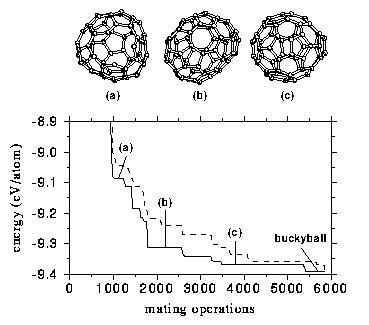A Genetic Algorithm for molecular structure optimization
Molecular geometry optimization with a genetic algorithm January 18, 1995, accepted for publication in Physical Review Letters
Nature, volume 376, number 6537, p.209 (20 July 1995) – John Maddox article written about the work
This work won Fastest Real Application award at Supercomputing '95

Summary
Atomistic models of materials provide accurate total energies. Practical applications, however, often require extremely long time scale simulations. Structural optimization of an atomic cluster requires a simulated annealing run whose length scales exponentially with the number of atoms in the cluster. Here, the 60 atom carbon buckyball is formed from random coordinates in our computer simulation.How we do it
- The genetic algorithm. Inspired by the Darwinian evolution process, a population of structures is maintained. New generations are produced by `mating' clusters and selecting the lowest energy relaxed children.
- Carbon clusters in a tight-binding model. We found fullerene cages starting from random coordinates, including the 60 atom buckyball illustrated above.
- The mating procedure. We use a cut and mating operation. The parent clusters are split in half and the child is created from one half of each parent. Mutations may also be applied.


Other applications
We have applied the physical cut-and- mating genetic algorithm to other systems, including point charges on a sphere (Thomson problem), lattice spin glass models in 2D and 3D, and Lennard-Jones clusters.